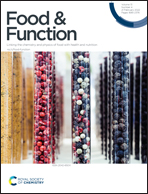The contribution of gastric digestion of starch to the glycaemic index of breads with different composition or structure
Abstract
Breads of higher density exhibit lower glycaemic index (GI) both in vivo and in vitro, a phenomenon generally attributed to a slower intestinal starch digestion. The aim of this work was to gain a better understanding of the relationship between bread density, oral and gastric digestion, and GI. Three breads were studied: industrial-style and traditional-style French baguettes (similar composition, different densities), and whole-wheat baguette. In vitro GI predictions confirmed that, for an identical composition, higher bread density was associated with a lower GI. Subsequent oro-gastric digestions, using the dynamic system DIDGI®, showed extensive starch digestion at the gastric stage by salivary α-amylase, in line with recently published data. They further showed that higher bread density led to a lower hydrolysis rate. The concurrence of these results with those of in vivo studies, suggests a mediating role for gastric digestion in the relationship between bread density and GI, possibly via the repercussions on the starch proportion that remains to be hydrolysed in the small intestine. This study therefore adds to the scientific knowledge of the importance of salivary α-amylase to starch digestion, and draws special attention to the possible role of the gastric phase in determining the GI.

- This article is part of the themed collections: Food & Function HOT Articles 2022 and Effect of food matrix & processing on the physiological fate of bioactive compounds & metabolites


 Please wait while we load your content...
Please wait while we load your content...